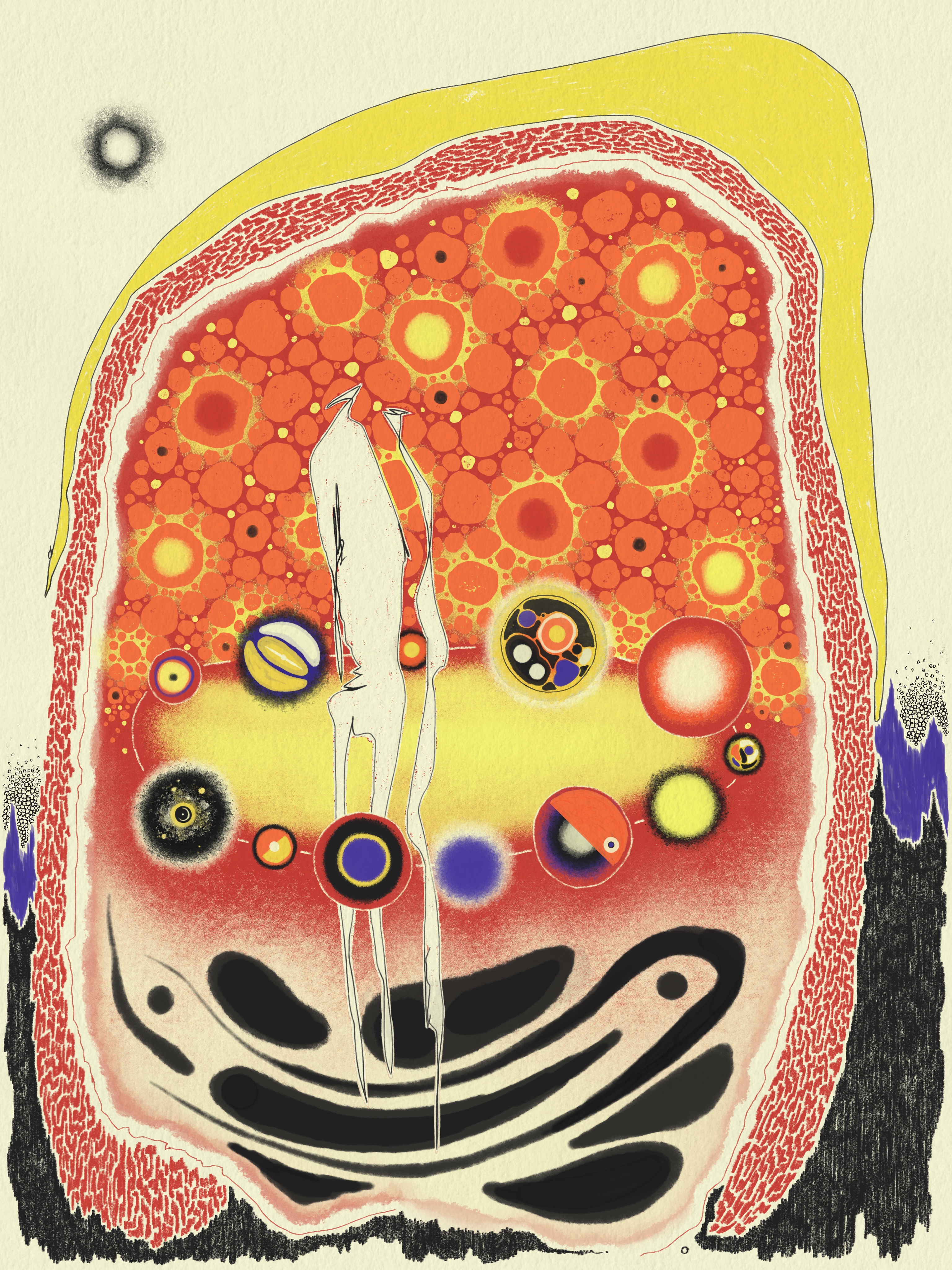IMN #29 — omentejovem

It's Monday Night #29
Tonight, let’s share thoughts about @omentejovem's work: a series of dreamlike digital paintings of surrealist inspiration that form a procession of hallucinatory interior landscapes.
Each of @omentejovem's works is for me like a page of a diary, both lyrical - expressive, sentimental, pathetic - and abstract - cold, geometric, disembodied.
It contains a fractured mental landscape, yet partly structured by recurring motifs, guiding lines, an arrangement of surfaces and colors that leaves nothing to chance.
Each painting has its own dynamism, maintained by a lively tension between contour and color, even if one can obviously distinguish between phases or sequences in the visual language of @omentejovem.
I distinguish a "symbolic" moment, of an esoteric nature (close to Dali), a "surrealist" moment (close to Miro) and a moment of "chemical hallucination" (close to certain drawings by Henri Michaux).
In the first case, the digital painting gives itself as an enigma or, more precisely, as a dream that is in fact an enigma. Each element seems to have a hidden meaning, which one should try to interpret by transposition or translation.
The question here is not to know what this meaning is precisely - as we would seek to know in a psychoanalytical approach. What is interesting is that the arrangement of the figures appears to us as a riddle or as a mystery that defies our ability to decipher it.
The paradoxical structuring of the space (a space that is intellectually impossible and yet perceived without the slightest discontinuity by the viewer), the presence of clearly defined archetypes (the staircase, the ladder, the moon, etc.) and...
...the play of colors based on the contrast of blue (night) and yellow (light) accentuate this feeling of a dream to be interpreted.
The pictorial unconscious speaks in symbol.
In the second case (surrealism à la Miro), the symbols fragment - and with them the idea that the essential is hidden - and the conflict between line and color deepens and becomes more radical.
Let's go further: color and line come into conflict with themselves.
The smooth confronts the rough, the straight line opposes the squiggle, the mixed struggles against the pure, etc. It overflows and it doesn't stay in place.
But the demand for meaning persists and it is still possible to tell oneself something about what is seen: here and there emerges the outline of a scene or a drama, figures, characters, alliances and strategies of encirclement.
Indeed, one would think one could recognize a narrative logic in the way the forms are assembled and disassembled.
Moreover, there is a strong formal homogeneity from one painting to another: on the one hand, an accumulation and concentration of tiny patterns, on the other, large irregular blocks more or less monochromatic.
Between the unity and the multiplicity, between the hole and the full, between the drawing and the coloring, the surrealism does not build binary oppositions but produces, from overflowing juxtapositions and by bringing together, a pure effect of staggering.
In the third case (the chemical hallucination), the frames of the perception are undone and the objects are like brought back to their luminous radiation: condensation, dilation, brightness, radiation.
I don't know if this is a conscious or unconscious quotation, but I think I can find in it the drawings under mescaline of the Belgian poet Henri Michaux.
It is less the representation of the world of objects than the stylized documentation or archiving of an alteration of perception under the effect of a chemical substance.
More precisely, @omentejovem would propose something like a phenomenology of consciousness or of the altered flow of consciousness: it is the ideal (unattainable, but stimulating) of an objective image of hallucinating subjectivity.
This does not mean that a character or a singular figure cannot appear in it, but it is a sensitive grammar in which the apparatus of perception has slightly stalled and is plunged into a state of increased receptivity to visual stimuli.
The hallucinogenic paintings of @omentejovem represent uninhabitable, impracticable places, towards which there is only one possible relationship:
contemplation, through an intentionality without object, in which the "subject" is looked at - stared at - by what they see (the too bright colors, the clumped spheres, the dislocation of the forms).
There is an invariant found in the different "styles" of @omentejovem: the color orange, which is between yellow and red on the visible light spectrum.
In the associative traffic of any viewer, color carries heat, fire, energy, party, devil, sun at its rising and setting.
It is a color that is rarely dominant, but it acquires a role of first choice with the impressionists and their successors.
One of the reasons is that the orange pigment, placed next to the azure blue, makes all colors more brilliant.
In a sense, @omentejovem appropriates the impressionist axiom: orange is a turbulent color, with a very high visibility, which immediately calls the attention.
Orange is almost systematically opposed to blue in @omentejovem, which produces a general intensification of the chromatic field and seizes the viewer's eye sharply - almost aggressively.
But, in the polyphony of @omentejovem's paintings, this alliance of colors under the authority of orange (normally secondary color), which destabilizes each painting, comes to define the unity of a language, by an intimacy & a renewed body to body with the mixture of red & yellow.
Orange imposes itself as the only focal point of a gaze in constant transformation: it is both a landmark in the delirium and the proof of the madness that seizes the eye of the spectator.
Thus, it is the color of an altered perception - color which is itself the product of the mixture of two primary colors - which becomes the common denominator of @omentejovem's dreamlike landscapes.